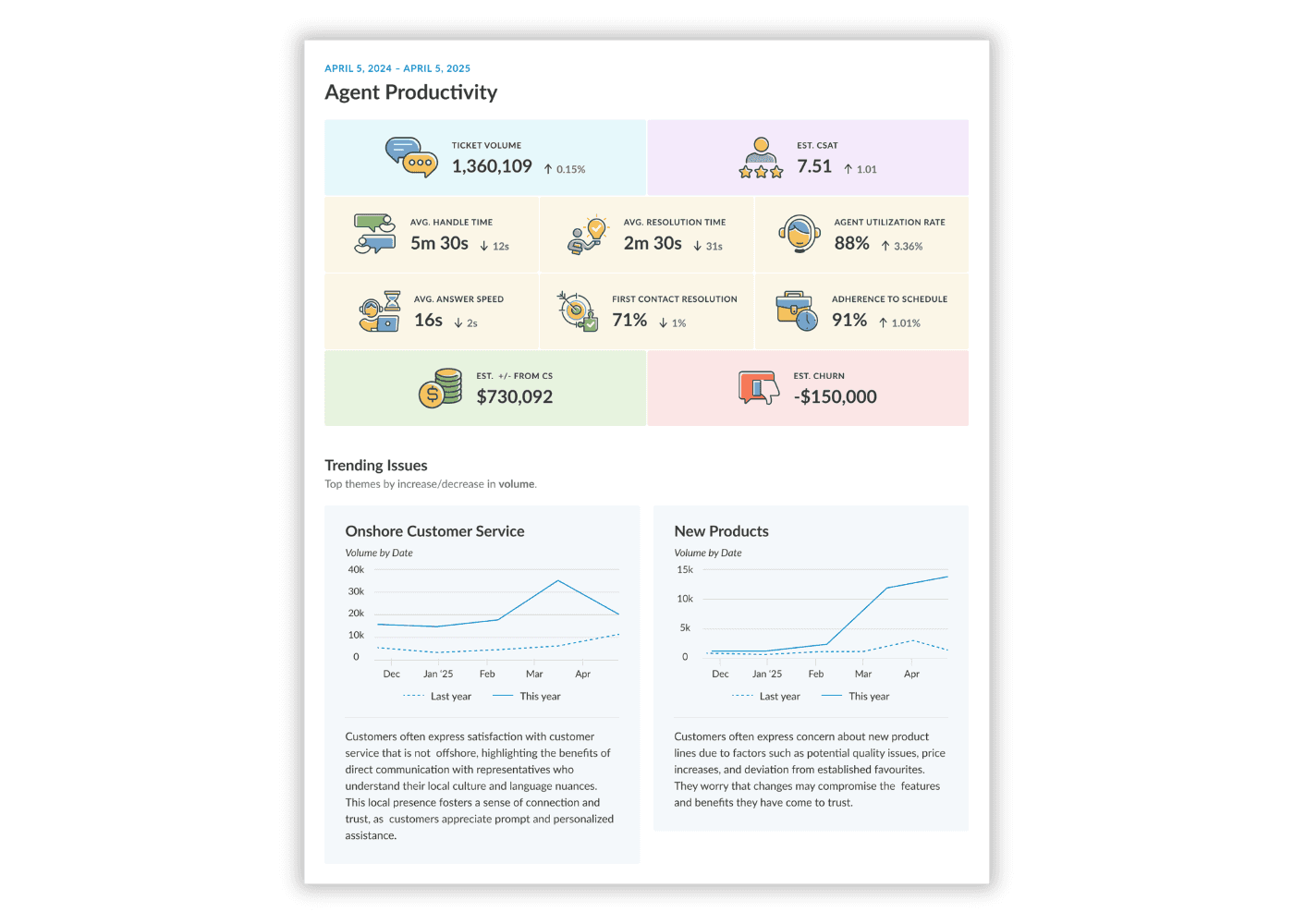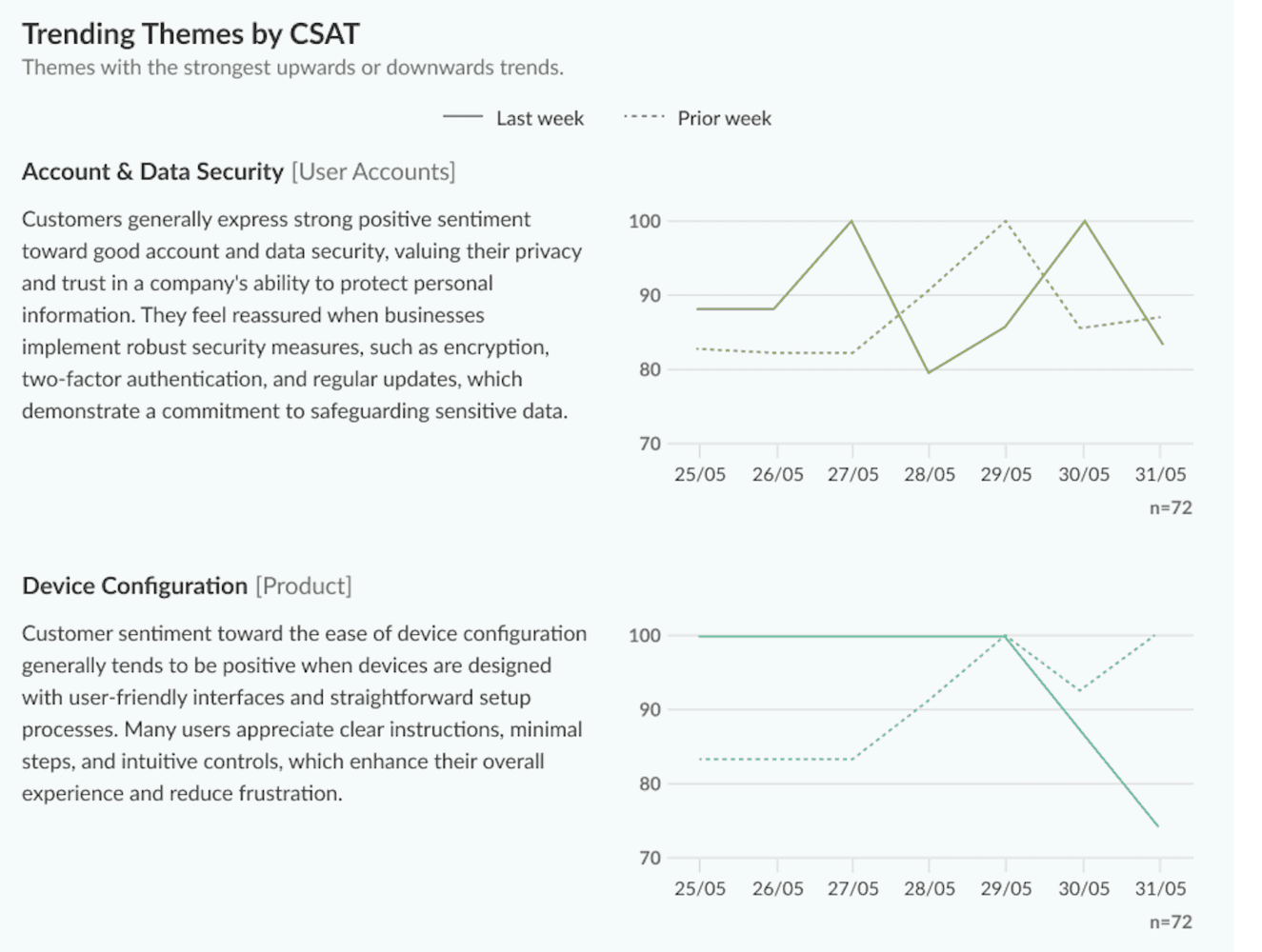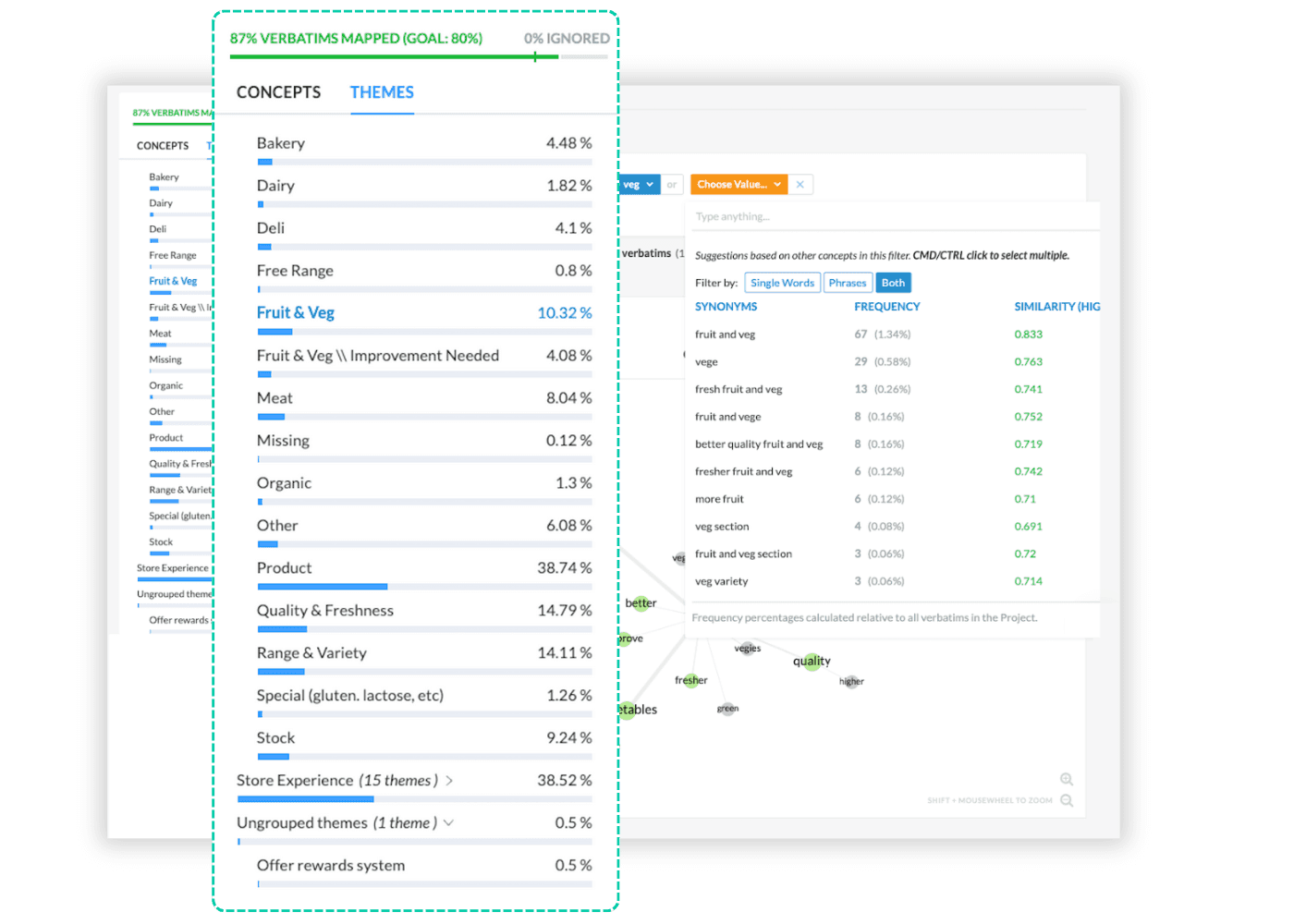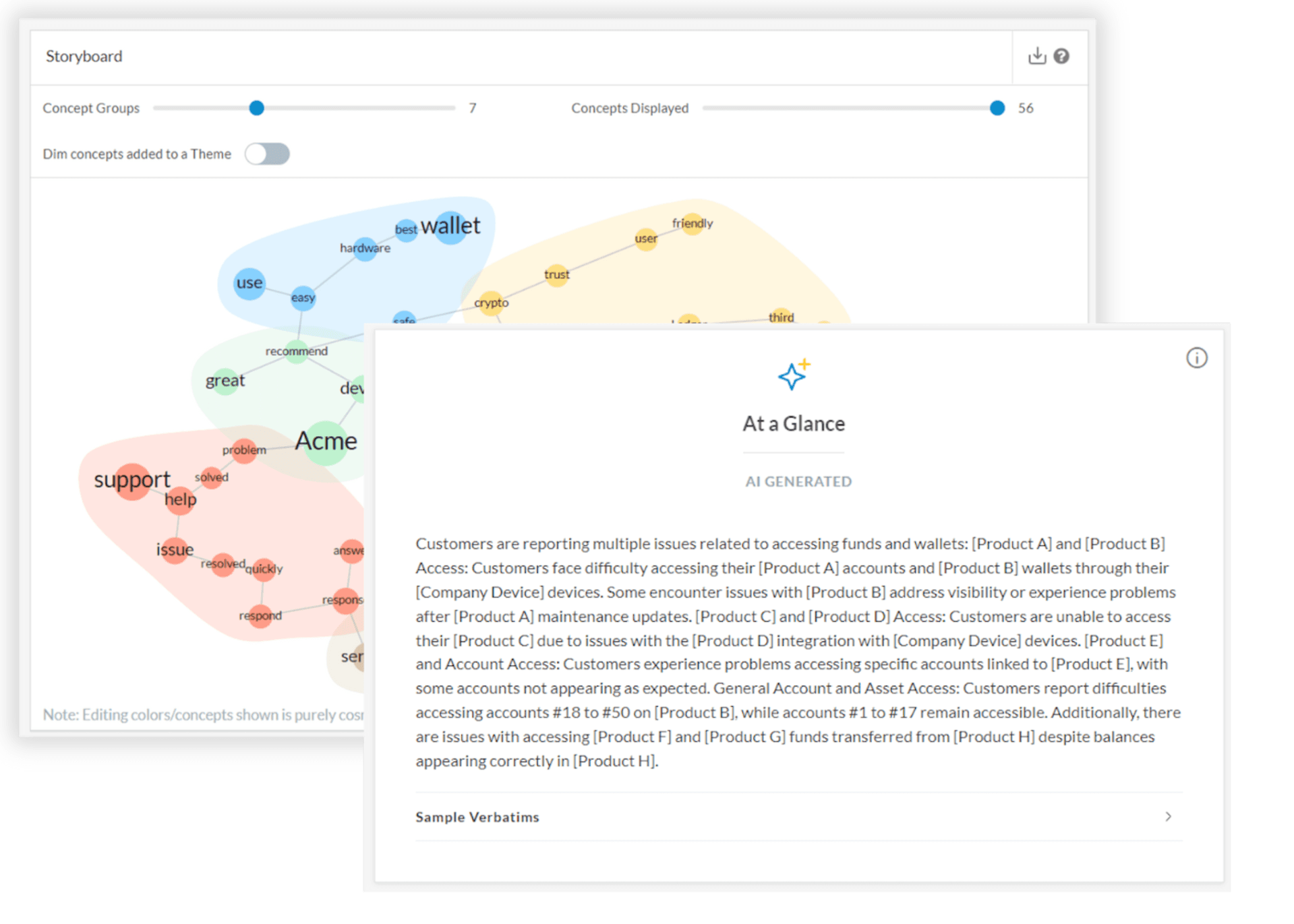Every Head of Customer Support knows the feeling. You’re sitting in a leadership meeting, presenting quarterly metrics that paint a troubling picture: CSAT scores trending downward, customer complaints increasing, first-call resolution rates stagnating. The numbers tell a clear story of declining performance, but they don’t answer the most critical question—why?
This scenario plays out in boardrooms across industries every quarter. Support leaders find themselves armed with comprehensive dashboards and detailed analytics, yet completely unable to explain the root causes behind shifting customer sentiment. They can tell you exactly how many tickets were resolved yesterday, but they’re stumped when asked what’s actually frustrating customers or how to prevent future issues.
Here’s a reality check that should make every contact center leader pay attention: 85% of customer service leaders are exploring generative AI solutions in 2025. The writing is on the wall. Contact centers that embrace AI-powered insights aren’t just staying competitive—they’re leaving everyone else in the dust.
Contact center industry trends and center technology trends, like AI, automation, and cloud-based solutions, are rapidly shaping the future, and contact center leaders need to pay close attention to drive operational efficiency and customer satisfaction.
Below are five trends that are worth every support leader investigating to see how your team might benefit.

Introduction to the Contact Center Industry
The contact center industry stands at the heart of modern customer engagement, acting as the primary touchpoint for customer inquiries, issue resolution, and ongoing support.
Today, contact centers are more than just call centers. They are dynamic hubs that shape customer satisfaction and influence brand loyalty. As customer expectations continue to evolve, companies are under increasing pressure to deliver more personalized customer experiences and provide timely support across multiple channels.
Recent years have seen the contact center industry undergo rapid transformation, fueled by technological advancements and the demand for seamless, frictionless customer journeys. Contact center managers are now tasked with not only meeting but exceeding shifting customer expectations, ensuring that every interaction contributes to a positive overall experience. The ability to adapt to these changes and leverage new tools is essential for maintaining high levels of customer satisfaction and staying competitive in an ever-changing marketplace.
Current State of Contact Center Leaders
Contact center leaders are the driving force behind successful contact center operations, responsible for orchestrating efficient customer interactions and delivering exceptional customer experiences. The role has never been more critical, as businesses recognize that customer satisfaction is directly linked to customer loyalty and long-term business growth. To achieve these goals, contact center managers must stay ahead of key contact center trends and adopt innovative center technology that streamlines operations and empowers agents.
Today’s leading contact centers are embracing cloud-based contact center solutions, robotic process automation, and advanced self-service options to handle increasing call volumes and rising customer expectations.
By integrating self-service tools and automation, leaders can reduce contact center costs, improve customer satisfaction scores, and free up agents to focus on more complex customer needs. Staying informed about the latest center trends and best practices enables contact center managers to optimize agent performance, enhance customer experiences, and ensure their teams are equipped to handle the demands of the modern contact center environment.
The five trends below are essential for every customer support leader to consider and evaluate how to keep their organization competitive in an era of rapid change.

Trend #1: AI-Powered Quality Assurance and Agent Coaching
Let’s start with a dirty little secret in the contact center industry: most QA programs are essentially guesswork.
Traditional quality assurance reviews may be 2 calls per agent per month, if you’re lucky. That’s roughly 1-5% of all customer interactions. Imagine trying to judge a movie based on watching 30 seconds of random clips. That’s essentially what contact centers have been doing with customer service quality for decades.
The problem isn’t just the small sample size. It’s the lag time. By the time a QA manager identifies that an agent needs coaching on handling billing inquiries, hundreds more customers have already had subpar experiences. It’s like trying to steer a ship by looking in the rearview mirror.
This is where AI-powered quality assurance becomes a game-changer. The numbers tell the story: 85% of contact center managers are likely to implement conversation intelligence in the next year, and early adopters are seeing dramatic results. Customer service representatives using AI chatbots save up to 2 hours and 20 minutes daily, allowing them to focus on more complex issues. AI is streamlining operations by automating repetitive tasks, such as routine inquiries, which empowers agents to focus on higher-value interactions and significantly boosts agent productivity.
This isn’t about replacing human judgment. It’s about augmenting it. Empowering agents with AI-driven tools also improves agent scheduling and supports customer service agents in delivering better outcomes.
How AI-Powered QA Actually Works
100% coverage vs. random sampling: Instead of reviewing 2 calls per agent monthly, AI analyzes every single customer interaction. Every. Single. One.
Real-time coaching recommendations: Agents get immediate feedback during live calls, not weeks later in a performance review.
Automated performance scoring: Customizable criteria ensure scoring aligns with your specific business goals and customer experience standards.
Predictive agent burnout prevention: Workload analysis identifies agents at risk before they hit their breaking point.
Consider how Kapiche's Auto QA feature transforms this process. Rather than hoping a random sample catches performance issues, it analyzes every customer conversation to provide personalized coaching insights. The result? Support teams move from reactive problem-solving to proactive performance optimization.
The best part? This technology doesn't just help struggling agents—it amplifies your top performers too. By identifying what makes your best agents successful, AI can help train everyone to those higher standards.

Trend #2: Predictive Analytics for Proactive Customer Service
Here’s a sobering statistic that should wake up every contact center leader: 61% of call center managers report increased volumes since 2020-2021, and 58% expect this trend to continue. Translation? The old reactive model of customer service (wait for problems, then fix them) is becoming unsustainable.
Smart contact centers are flipping the script. Instead of playing defense, they’re going on offense with predictive analytics.
Think of predictive analytics as your contact center’s crystal ball. It doesn’t just tell you what happened, it predicts what’s about to happen. Predictive analytics provide actionable insights and valuable insights into customer behavior, pain points, and customer queries, helping optimize call center operations. And the results speak for themselves: when contact centers implement predictive and big data analytics, productivity can increase as much as 60%.
But what does this look like in practice? Let’s break it down.
The Power of Prediction in Action
Churn prediction modeling: AI analyzes conversation patterns to identify customers at risk of leaving before they actually cancel. A frustrated tone combined with specific keywords can flag accounts for proactive retention efforts.
Issue escalation prevention: Spot emerging problems before they impact your CSAT scores. If multiple customers start mentioning the same product issue, predictive analytics can alert your team before it becomes a viral complaint on social media.
Seasonal volume forecasting: Historical data combined with external factors (holidays, product launches, economic trends) helps optimize staffing and prevent those dreaded long hold times.
Real-time sentiment analysis: By 2025, nearly 95% of customer interactions will be processed through sentiment analysis tools, enabling immediate intervention when conversations go south.
This is where platforms like Kapiche shine. Their real-time analytics don't just collect data—they transform it into actionable intelligence. When emerging issues surface in support conversations, teams can intervene proactively rather than waiting for problems to compound.
Here's a real-world example: A SaaS company noticed their analytics flagging increased mentions of "login problems" across support calls. Instead of waiting for the issue to escalate, they proactively sent app notifications with troubleshooting tips to all users. Result? They prevented thousands of support tickets and maintained customer satisfaction during what could have been a major outage.
The shift from reactive to proactive isn't just about better customer service—it's about better business. Every issue you prevent is money saved and reputation protected.

Trend #3: Unified Customer Data Platforms for 360-Degree Insights
Contact centers are drowning in data. Literally drowning.
Contact centers capture thousands of customer interactions daily across voice, email, chat, and social channels. The global contact center market is expected to rise to $113 billion by 2027, largely driven by organizations scrambling to make sense of all this information.
The problem most support teams face is that most of this valuable data lives in silos.
Your support tickets sit in one system. Survey responses live in another. Social media mentions are tracked separately. Product feedback gets lost in yet another platform. It’s like having puzzle pieces scattered across different rooms and wondering why you can’t see the big picture.
Forward-thinking contact centers are breaking down these walls with unified customer data platforms. Cloud contact center technology and cloud-based contact centers enable seamless integration of data sources and provide the scalability needed to adapt quickly to changing business demands.
What Unified Data Actually Means
Breaking down data silos: Support, CX, and product teams work from the same source of truth instead of competing versions of reality.
Cross-channel customer journey mapping: See how customers move from social media complaints to support calls to survey responses—and identify friction points along the way.
Integrated feedback from all touchpoints: Combine structured survey data with unstructured conversation insights for a complete customer perspective.
VoC 2.0 methodology: Move beyond traditional surveys to capture insights from every customer conversation, not just the 10-15% who fill out forms.
This is where Kapiche's approach becomes particularly powerful. By integrating surveys, support tickets, reviews, and social media into one insights platform, they create what they call an "always-on feedback brain." This isn't just data aggregation—it's intelligent synthesis that reveals patterns no single data source could uncover.
The real magic happens when this unified data becomes accessible to distributed teams. Remote workers can access the same customer insights as office-based colleagues, ensuring consistent service quality regardless of location.

Trend #4: Hybrid Workforce Management and Remote Operations
Remember when working from home was considered a “nice-to-have” perk for high-performing agents? Those days are history.
The numbers tell a clear story. As of Q1 2025, 4 in 10 jobs allow some amount of remote work. And 73% of call center leaders intend to offer long-term remote or hybrid work options with the aim of improving agent recruitment and retention.
The contact centers that figure out how to manage hybrid workforces effectively won’t just maintain service levels, they’ll exceed them.
But hybrid workforce management comes with unique challenges that traditional contact center tools weren’t designed to handle. Secure remote operations now require the use of virtual private networks and VPN multi-factor authentication to protect sensitive data and ensure only authorized access to cloud systems.
The New Reality of Hybrid Operations
Distributed team performance monitoring: How do you coach an agent in Denver while managing another in Mumbai, especially when they're handling the same customer accounts?
Always-accessible insights: Remote agents need instant access to customer context, performance data, and coaching feedback—not just during scheduled check-ins.
Cloud-based conversation analytics: Traditional on-premise systems can't support the flexibility that hybrid teams require.
Maintaining service quality: Ensure consistent customer experience whether your agent is in the office, at home, or working from a different continent.
This is where Kapiche's "always-on feedback brain" becomes a strategic advantage. By providing real-time customer insights that are accessible regardless of location, distributed teams can maintain—and often exceed—the performance levels of traditional co-located teams.
The hybrid workforce trend isn't going away. The contact centers that treat it as a strategic opportunity rather than an operational challenge will have a significant competitive edge in 2025 and beyond.

Trend #5: Real-Time Sentiment Analysis and Voice of Customer 2.0
Here’s a statistic that should make every contact center leader rethink their approach to customer feedback: Post-contact survey response rates typically hover between 5–10%. For all surveys attempted, only a fraction get completed.
This means you’re making business decisions based on feedback from maybe 5-10% of your customer interactions. It’s like trying to understand a movie by reading reviews from people who only watched the credits.
The most valuable customer insights aren’t hiding in survey responses—they’re happening in real-time during every support conversation. And smart contact centers are finally figuring this out. Real-time analytics empower contact centers to handle customer interactions seamlessly across digital channels, enabling them to deliver a more personalized customer experience that meets evolving expectations.
The momentum is undeniable: experts predict that 90% or more of Fortune 500 companies will use sentiment analytics tools for customer feedback within five years. This is a fundamental shift in how we think about customer feedback.
Consider the competitive advantage: organizations that tap into real-time voice of customer data can spot emerging issues, coach agents in the moment, and proactively improve service. Leveraging these insights enables a personalized customer experience that drives loyalty.
Welcome to VoC 2.0
Moving beyond post-call surveys: Instead of hoping customers fill out forms, analyze the conversations that are already happening.
Real-time emotion detection: Identify frustration, confusion, or delight as it occurs during customer interactions, not days later through survey responses.
VoC 2.0 methodology: Analyze 100% of customer conversations versus the small sample of traditional survey responses.
Automatic theme discovery: Let AI uncover emerging issues and trends from unstructured conversation data without predefined categories.
This is where Kapiche's approach represents a true evolution in customer feedback analysis. Their AI-powered auto themes and conversation analytics transform every support conversation into actionable customer insights. It's not just about collecting more data—it's about capturing the context and nuance that traditional surveys miss entirely.








